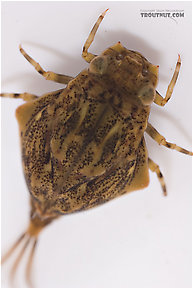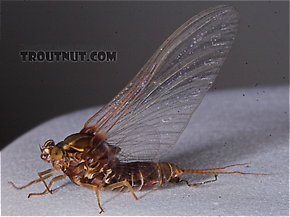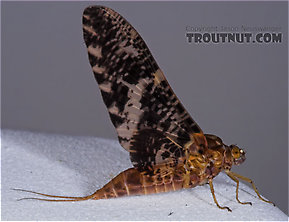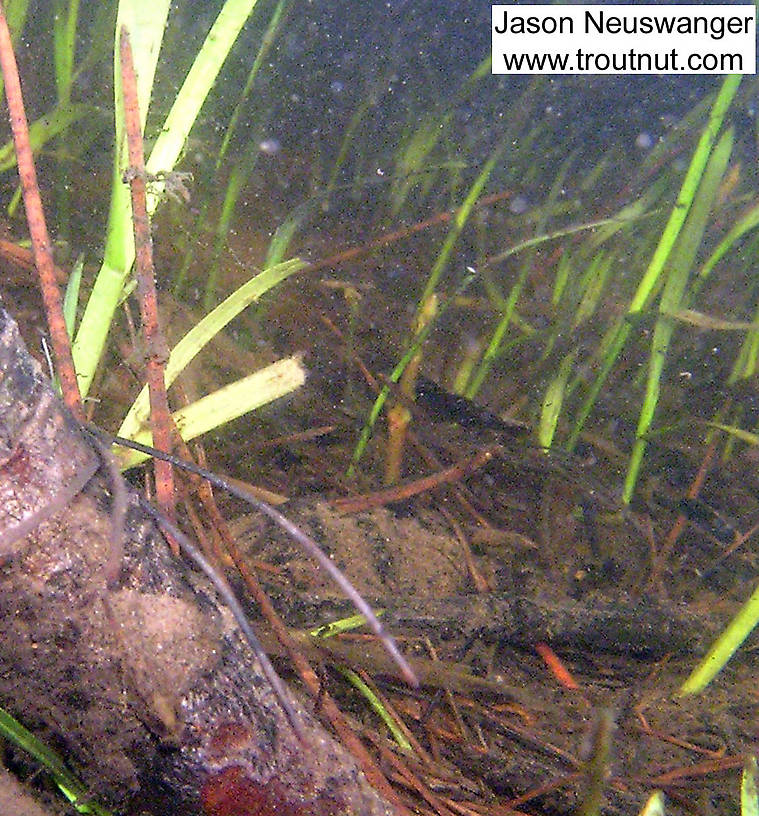Blog & Latest Updates
Fly Fishing Articles
Insects by Common Name


Mayfly Genus Baetisca (Armored Mayflies)
Taxonomic Navigation -?-
Kingdom
Animalia (Animals)
» Phylum
Arthropoda (Arthropods)
» Class
Insecta (Insects)
» Order
Ephemeroptera (Mayflies)
» Family
Baetiscidae (Armored Mayflies)
» Genus Baetisca (Armored Mayflies)
| Species in Baetisca | ||
| Baetisca columbianaArmored Mayfly | 0 | 0 |
| Baetisca laurentinaArmored Mayfly | 0 | 1 |
| Baetisca obesaArmored Mayfly | 0 | 0 |
9 species aren't included.
Common Names
Their primary claim to fame is their peculiar shape, both as nymphs and as adults. On most rivers they are a rare oddity, but there are places where their spinner falls elicit greedy rises and staunch selectivity from the trout. These spinners never even come close to blanketing the water, but trout have such an affinity for them that even their sparsest falls should excite the angler.
I favor two explanations for their importance. First, they have a very stout profile, and late-season beetle action suggests that trout like this trait. Second, the Baetisca action lasts for up to a month on a single stretch of water. This caters to the selective trout's love of the familiar.
Where & When
I have found good populations of Baetisca laurentina in three drainages in northern Wisconsin, where their activity peaks in early June but continues through the rest of the month. I've known fish on the Bois Brule River to feed greedily and selectively on Baetisca spinners. In the East, where the major species is Baetisca obesa, Ernest Schwiebert reported their importance on the Neversink in the Catskills, and I've heard multiple reports of Baetisca spinner fall rises on the Battenkill in Vermont.
Hatching Behavior
Baetisca nymphs crawl out of the water to emerge, which may take ten minutes or more, so the duns are of no interest to the trout. They are unique among mayflies in that they may crawl more than one meter from the water to emerge, a behavior reported in Edmunds and McCafferty's The Mayfly Subimago. Some stoneflies do this, but other mayflies which crawl out of the water only go a few inches.
The duns are pretty insects with stout bodies and Dalmatian-speckled wings which become clear when they molt into spinners.
Spinner Behavior
Time Of Day: Mid-evening. They usually fall from 8 to 9 p.m., but can anytime from 6:30 to dusk. Sometimes dawn.
Habitat: Both riffles and calm runs
Where Baetisca spinners are abundant, they inspire fierce selectivity in the trout, which relish them above all else on certain spring evenings. They suck Baetisca spinners down with aggressive gulps usually reserved for the fluttering duns of meaty drakes. I have watched these spinners upstage larger or more prolific maylies many times, although this cannot always be expected.Habitat: Both riffles and calm runs
Notice in my photos that the female spinners are extremely fat mayflies (don't tell them I said that). The males, though still not as slender as a normal mayfly, are much less robust. Spinner patterns should imitate the full-figured females, because they seem to be more common on the water than the males.
They are rarely spent (Spent: The wing position of many aquatic insects when they fall on the water after mating. The wings of both sides lay flat on the water. The word may be used to describe insects with their wings in that position, as well as the position itself.) as soon as they fall on the water. They float at first with their wings upright like duns, and then many collapse half-spent (Spent: The wing position of many aquatic insects when they fall on the water after mating. The wings of both sides lay flat on the water. The word may be used to describe insects with their wings in that position, as well as the position itself.) for quite a while before finally losing their energy and becoming fully spent (Spent: The wing position of many aquatic insects when they fall on the water after mating. The wings of both sides lay flat on the water. The word may be used to describe insects with their wings in that position, as well as the position itself.). These upright and half-spent (Spent: The wing position of many aquatic insects when they fall on the water after mating. The wings of both sides lay flat on the water. The word may be used to describe insects with their wings in that position, as well as the position itself.) phases last longer with Baetisca spinners than with other mayflies.
I have always fished Baetisca spinners in the evening in Wisconsin, but an early-rising friend reports spinner falls very early in the morning over slow water in Michigan.
Nymph Biology
Current Speed: Slow to medium
Substrate: Very diverse: cobble, gravel, sand, silt
Environmental Tolerance: Schwiebert writes that they prefer cold, acid watersheds, but I have found fishable populations in alkaline (Alkaline: Having a pH higher than 7 (opposite of acidic). Moderately alkaline water is ideal for trout because it's better for the growth of phytoplankton, the usual base of the aquatic food chain, and that's good for the growth of everything higher up the chain, including trout.) streams of marginal temperature as well.
In Nymphs, Ernest Schwiebert describes his first encounter with abundant Baetisca nymphs on a wild Catskill river. He implies that their imitation can be important by describing a fly-tying method to create their peculiar shape. I have caught trout by imitating these nymphs, but I doubt those fish were feeding selectively.Substrate: Very diverse: cobble, gravel, sand, silt
Environmental Tolerance: Schwiebert writes that they prefer cold, acid watersheds, but I have found fishable populations in alkaline (Alkaline: Having a pH higher than 7 (opposite of acidic). Moderately alkaline water is ideal for trout because it's better for the growth of phytoplankton, the usual base of the aquatic food chain, and that's good for the growth of everything higher up the chain, including trout.) streams of marginal temperature as well.
Several authors write that the nymphs submerge themselves in the thin layer of silt and detritus (Detritus: Small, loose pieces of decaying organic matter underwater.) that accumulates in the calm shallows. I do collect the most nymphs from such habitats, but they are also found on large rocks in riffles and on sunken logs.
Baetisca nymphs are surprisingly fast swimmers given their awkward shape. They move like Baetis nymphs wearing backpacks. See my video at the bottom of this page.
Baetisca Fly Fishing Tips
It is essential to imitate the thick, opaque body of the Baetisca spinners with a specialized fly. A normal thin-bodied spinner pattern in the right color and hook size once left me skunked after 45 minutes casting to two dozen selective Baetisca-feeding trout. I do not repeat that mistake.
I wrap an underbody of thin closed-cell foam to the appropriate profile and dub over it. Fly shops in Baetisca country sell patterns with heavy badger hackle, because the dark inside color is suggestive of the spinner's thick body. Both patterns can work.
This article owes much to the helpful corrections of Cordell Manz, a Baetisca buff and top-notch guide on the Bois Brule River in Wisconsin.
Pictures of 25 Mayfly Specimens in the Genus Baetisca:
Baetisca obesa (Armored Mayfly) Mayfly Nymph View 12 Pictures
View 12 Pictures
 View 12 Pictures
View 12 PicturesCollected May 6, 2007 from the Neversink River (above reservoir) in New York
Added to Troutnut.com by Troutnut on May 10, 2007
Added to Troutnut.com by Troutnut on May 10, 2007
Female Baetisca laurentina (Armored Mayfly) Mayfly Spinner View 9 Pictures
View 9 Pictures
 View 9 Pictures
View 9 PicturesCollected June 1, 2005 from the Bois Brule River in Wisconsin
Added to Troutnut.com by Troutnut on May 24, 2006
Added to Troutnut.com by Troutnut on May 24, 2006
Female Baetisca laurentina (Armored Mayfly) Mayfly Dun View 7 Pictures
View 7 Pictures
 View 7 Pictures
View 7 PicturesCollected June 5, 2005 from the Marengo River in Wisconsin
Added to Troutnut.com by Troutnut on May 25, 2006
Added to Troutnut.com by Troutnut on May 25, 2006
1 Underwater Picture of Baetisca Mayflies:

There's a very well-camouflaged Baetisca laurentina mayfly nymph resting on the twig in the bottom left corner of this picture. Can you spot him?
In this picture: Mayfly Species Baetisca laurentina (Armored Mayfly).
In this picture: Mayfly Species Baetisca laurentina (Armored Mayfly).
StateWisconsin
LocationNamekagon River
Date TakenApr 24, 2004
Date AddedJan 25, 2006
AuthorTroutnut
CameraOlympus C740UZ
Swimming Baetisca Mayfly Nymph
Starring: Baetisca Mayfly Nymph
The clumsy-looking mayfly nymphs of the genus Baetisca are surprisingly good swimmers.
LocationNamekagon River
Date ShotJan 31, 2004
Date AddedMar 31, 2006
AuthorTroutnut
CameraOlympus C740UZ
Recent Discussions of Baetisca
An important hatch 2 Replies »
Posted by Troutnut on Jun 26, 2006 in the species Baetisca laurentina
Last reply on Apr 8, 2013 by Willy
Based on reports from several sources and my own experiences, I'm beginning to think it is significantly more important than it has been credited for. The duns emerge by crawling out onto land, so they aren't important, but some of my most memorable fishing nights of 2005 were due to Baetisca spinner falls.
It is a tricky hatch to detect. I haven't seen more than a couple of their spinners in the air at a time, though some of my friends report spotting their swarms. Normally for me they just showed up on the water from unseen swarms upstream. They were mixed with spinners from Ephemerella invaria and Maccaffertium vicarium, among others, but the fish were relentlessly selective to the Baetisca laurentina spinners.
I wasted the better part of an hour flinging a sulphur imitation the first time I encountered a Baetisca fall. Like Ephemerella spinners, they can be hard to spot on the water, and they were much more sparse. I finally captured one, noticed the very different body profile, and since I didn't have anything remotely imitating it I continued to catch no fish. I returned the next night with an imitation with a robust, opaque body, and the fish went crazy for it.
I just finished reading through the account by Caucci and Nastasi in Hatches II about how the extremely important Ephemerella invaria sulphur species went unnoticed for decades because it was confused with Ephemerella dorothea. The maddening difficulty of some dorothea hatches was partially explained away once people understood this difference.
Although Baetisca is much less prominent than Ephemerella invaria, I suspect it has similarly been confused with well-known sulphur species in the rare locations and occasions where it is important.
ReplyBaetisca in Vermont 1 Reply »It is a tricky hatch to detect. I haven't seen more than a couple of their spinners in the air at a time, though some of my friends report spotting their swarms. Normally for me they just showed up on the water from unseen swarms upstream. They were mixed with spinners from Ephemerella invaria and Maccaffertium vicarium, among others, but the fish were relentlessly selective to the Baetisca laurentina spinners.
I wasted the better part of an hour flinging a sulphur imitation the first time I encountered a Baetisca fall. Like Ephemerella spinners, they can be hard to spot on the water, and they were much more sparse. I finally captured one, noticed the very different body profile, and since I didn't have anything remotely imitating it I continued to catch no fish. I returned the next night with an imitation with a robust, opaque body, and the fish went crazy for it.
I just finished reading through the account by Caucci and Nastasi in Hatches II about how the extremely important Ephemerella invaria sulphur species went unnoticed for decades because it was confused with Ephemerella dorothea. The maddening difficulty of some dorothea hatches was partially explained away once people understood this difference.
Although Baetisca is much less prominent than Ephemerella invaria, I suspect it has similarly been confused with well-known sulphur species in the rare locations and occasions where it is important.
Hi there; I just gathered a sample from our local Black River here in SE Vermont, and found a thriving population of armored mayflies. Wasn't sure what they were at first, with their bubble-humped backs and short little tails, but once I used my hand lens I realized they have tiny little "thorns" behind their last legs. Their mottled coloring resembles everything I've seen here, confirming my ID. I'll be sending off a sample to a friendly bug lab to let the pros look at them.
ReplySimiliar found in Minnesota 1 Reply »Posted by PRohlfsen on May 11, 2007 in the species Baetisca obesa
Last reply on May 11, 2007 by Troutnut
I was fishing the Vermillion River in Minnesota south of the metro area and found a nymph similar to the Armored Mayfly Nymph. It did appear to be much more green in color. It was moving through a really muddy part of the stream, which I found interesting.
ReplyCan't wait to hit this hatchPosted by Troutnut on Jun 12, 2006 in the species Baetisca laurentina
It sounds like the Baetisca hatch is really going on here in northern Wisconsin now. I've heard reports from more than one source about fishable Baetisca laurentina hatches on two of my favorite rivers. I bought some imitations and hopefully I'll be using them tomorrow!
ReplyYour Thoughts On Baetisca:
Top 10 Fly Hatches
Top Gift Shop Designs
Eat mayflies.
Top Insect Specimens
Miscellaneous Sites
Troutnut.com is copyright © 2004-2024 Jason
Neuswanger (email Jason). See my FAQ for information about use of my images.
 privacy policy
privacy policy
